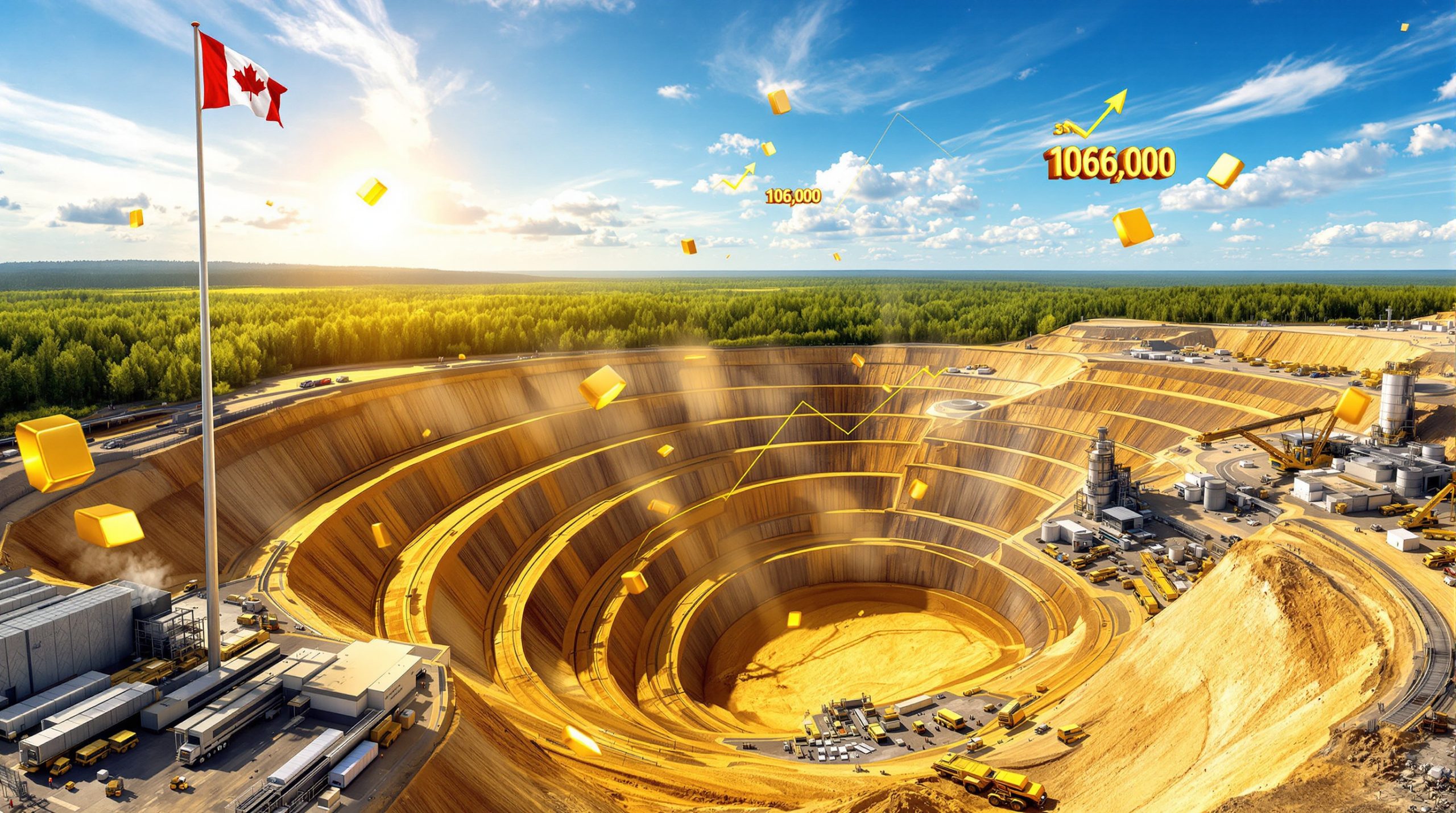How Will Australia's Gold Production Change Through 2057?
Australia's gold industry stands at a critical crossroads. According to comprehensive analysis by MinEx Consulting (2017), the nation's gold sector faces significant transformation over the coming decades that will reshape production, employment, and revenue across the entire industry.
Current Production Landscape
Australia currently produces approximately 9.7 million ounces (Moz) of gold annually, positioning the country as one of the world's premier gold producers. This substantial output comes from 71 active gold mines scattered across the continent, particularly concentrated in Western Australia's goldfields region.
The gold sector serves as a crucial economic pillar, directly employing nearly 28,000 workers in mining operations while generating annual revenue exceeding A$14 billion. This significant contribution to Australia's economy highlights the importance of understanding the long-term forecast of Australia's mineral production and revenue in gold.
Short-Term Production Outlook (2017-2022)
In the immediate future, Australia's gold production is expected to maintain stability at approximately 9.7 Moz annually for the first two years. This plateau reflects the continued dominance of existing mines that currently form the backbone of national gold output.
However, beginning around 2019, the industry enters an initial decline phase as older mines start depleting their economically viable reserves. This transition period marks the emergence of early warning signs that foreshadow more significant production challenges on the horizon.
According to Richard Schodde of MinEx Consulting, "The stability we're currently experiencing masks underlying structural issues that will become increasingly apparent as existing operations mature."
Medium-Term Production Trajectory (2022-2032)
The medium-term outlook reveals accelerating production declines from existing operations as reserves deplete and grades diminish. While new projects based on known deposits will begin contributing to supply during this period, their combined output will prove insufficient to fully offset closures of aging mines.
By 2032, a critical milestone will be reached—approximately 50% of Australia's gold production will come from mines that have yet to be discovered. This represents a fundamental shift in the industry's foundation and highlights the essential role of exploration importance in sustaining future production.
"By 2032, half of Australia's gold production will come from mines yet to be discovered," notes Richard Schodde. "Government and industry need to support exploration today to avoid medium-term supply disruptions."
Long-Term Production Forecast (2032-2057)
The long-term projection presents a sobering reality for Australia's gold industry. Production is forecast to decline by approximately 50% over the 40-year period, with final production levels reaching 4.69 Moz annually by 2057—less than half of 2017 output.
Perhaps most striking is the complete transformation of the production landscape: only 4 of the original 71 mines operating in 2017 will still be active by 2057. These remaining original mines will contribute less than 0.4 Moz annually, representing a minor fraction of total production.
This dramatic shift underscores the finite nature of mineral resources and the continuous need for discovery and development to maintain production levels. The 13-year average delay between discovery and development further complicates this challenge, requiring immediate action to address future supply gaps.
What Economic Impacts Will the Gold Industry Experience?
The projected changes in gold production will trigger ripple effects throughout Australia's economy, affecting everything from export revenue to regional employment opportunities.
Revenue Projections
MinEx Consulting's analysis forecasts gold prices to average A$1,524 per ounce over the 40-year period (in 2017 dollars), with 90% probability that prices will range between A$793 and A$2,258 per ounce. This projection is based on sophisticated modeling of 1,000 probabilistic scenarios that account for historical price patterns and market fundamentals.
With declining production volumes, annual revenue is projected to decrease by approximately 50% to A$7.3 billion by 2057. This revenue decline correlates directly with production decreases, as the model shows limited ability for price increases to offset volume reductions over the long term.
The economic implications extend beyond direct mining revenue, as each dollar spent on gold exploration generates approximately A$11.40 in revenue according to the MinEx analysis—highlighting the multiplier effect of mineral development on the broader economy.
Employment Trends
The human impact of production changes will be substantial, with total industry employment projected to fall by 70%—from 27,980 to just 8,300 workers by 2057. This represents nearly 20,000 fewer direct mining jobs in the sector.
These workforce reductions will not occur suddenly but rather unfold gradually as existing mines reach the end of their economic lives. While new mines will create some employment opportunities, these additions will prove insufficient to offset the overall losses from mine closures.
The MinEx report also notes that changing mining technologies may further impact employment figures, as automation and remote operations reduce labor intensity even at productive mines. This technological shift could accelerate job reduction beyond the baseline projections.
Mining Operation Changes
Beyond pure production metrics, the fundamental structure of Australia's gold mining sector will transform substantially. The number of operating gold mines is forecast to decrease by 33% (from 71 to 47) by 2057, creating a more concentrated industry with fewer but potentially larger operations.
Average mine size and operational characteristics will likely evolve as well, with technological advancement driving improved efficiency to maintain competitiveness. This evolution may favor operations with access to capital for modernization investments and sufficient scale to justify such expenditures.
The geographic distribution of mining activity may also shift based on discovery locations, potentially creating new regional mining centers while legacy areas experience relative decline. These shifts could significantly impact regional communities currently dependent on gold mining employment and economic activity.
What Role Will Exploration Play in Australia's Gold Future?
Exploration represents the single most critical factor in determining Australia's future gold production trajectory. The MinEx analysis reveals just how vital new discoveries will be to mitigating production decline.
Exploration Investment Requirements
The baseline projection assumes annual exploration expenditure of A$677 million—slightly above current levels but well below what would be required to maintain present production volumes. This investment is expected to support the discovery of new deposits that will partially offset depletion of existing mines.
According to Richard Schodde's analysis, each additional dollar spent on exploration generates approximately A$11.40 in revenue, making exploration an economically rational investment despite its inherent risks. However, maintaining current production levels would require doubling exploration spending—a significant capital commitment.
An alternative approach identified in the report involves improving discovery efficiency to reduce unit discovery costs from the current average of A$70 per ounce to approximately A$35 per ounce. Such efficiency gains would enable similar discovery success with current spending levels, but would require technological innovation and improved targeting methodologies.
Discovery Forecasts and Development Timeline
The baseline forecast projects 266 new gold deposits to be discovered over the 40-year period, with approximately 50% of these discoveries eventually developed into operational mines. This development rate reflects historical patterns accounting for economic, technical, and regulatory factors.
These new discoveries are expected to contribute 4.06 Moz annually by 2057, representing 86% of total production. Without these new mines, Australia's gold production would decline precipitously to approximately 0.7 Moz annually—just 7% of current levels.
"Without new discoveries, production would plummet to 0.7 Moz by 2057," warns Schodde. "Exploration success will determine whether the decline is moderate or severe."
A critical challenge identified in the report is the 13-year average delay between discovery and development. This lengthy timeline means that discoveries made today won't contribute significantly to production until the 2030s, creating urgency for immediate exploration investment to prevent supply gaps in the medium term.
Impact of New Discoveries
The MinEx analysis quantifies the essential role of new discoveries in stark terms: by 2032, half of Australia's gold production will come from deposits that have yet to be found. By 2057, this dependency increases to 86% of total production.
Without successful exploration, Australia's gold industry would effectively cease to be globally significant by mid-century. This dependency creates both risk and opportunity—risk if exploration investment and success rates falter, opportunity if they can be enhanced beyond baseline projections.
The geographic distribution of these discoveries will substantially reshape the industry's footprint, potentially creating new mining districts while traditional areas decline. This geographic shift could create significant challenges for communities currently dependent on mining activity while opening opportunities in emerging regions.
What Challenges and Opportunities Face Australia's Gold Industry?
The forecast presents both substantial challenges and strategic opportunities for Australia's gold sector, requiring coordinated responses from industry, government, and research institutions.
Critical Industry Challenges
The most immediate challenge is addressing declining production from existing operations, many of which face grade deterioration and reserve depletion. These mature assets form the foundation of current production but will gradually contribute less over time.
Equally concerning is the long lead time between discovery and development, averaging 13 years according to MinEx analysis. This extended timeline creates urgency to address exploration performance within the next 2-3 years to avoid significant supply disruption in the medium term.
"Industry and government must act within 2–3 years to address exploration performance," emphasizes Schodde. "The incremental benefits justify urgent investment."
The report also highlights the increasingly complex technical challenges of finding new deposits, as most near-surface resources have already been discovered. Future exploration success will require detecting deposits at greater depths and under cover, necessitating more sophisticated exploration approaches.
Strategic Opportunities
Despite these challenges, significant opportunities exist for Australia to maintain its position as a premier gold producer. The analysis indicates potential to maintain current production levels through enhanced exploration investment or efficiency improvements.
The benefits of reaching optimal exploration targets are substantial: additional 4.05 Moz annual production by 2057, potential additional revenue of A$6.23 billion annually, and creation of approximately 7,160 additional jobs compared to the baseline scenario.
Australia maintains competitive advantages in its established mining expertise, supportive infrastructure, political stability, and prospective geology. These factors position the nation to potentially outperform global competitors facing similar resource depletion challenges if appropriate strategies are implemented.
Policy and Innovation Requirements
Realizing the more optimistic scenarios will require coordinated policy responses and industry innovation. Government policies that stimulate exploration investment—such as flow-through share schemes or tax incentives—could play critical roles in bridging the projected production gap.
Industry initiatives to improve discovery efficiency and effectiveness represent another vital pathway, potentially delivering similar benefits with lower capital requirements. Research and development to address specific geological challenges, particularly exploration under cover, will be essential to future discovery success.
Collaborative approaches between government, industry, and research institutions offer the most promising avenue for addressing these complex challenges. The MinEx report emphasizes that no single entity can solve these issues in isolation—success requires coordinated effort across the sector.
How Can Australia Address the Looming Gold Production Gap?
Addressing the projected production decline requires a multifaceted approach targeting key areas of innovation, regulation, and research.
Exploration Efficiency Improvements
Technological innovations in exploration methodologies represent a primary pathway to improved discovery rates. Advanced geophysical techniques for deeper deposit detection could unlock resources currently hidden beneath cover sequences that mask traditional exploration indicators.
Machine learning and artificial intelligence applications for target generation show particular promise, enabling more sophisticated analysis of complex geological datasets to identify subtle patterns associated with mineralization. These digital approaches could significantly enhance the efficiency of exploration programs.
Improved drilling technologies for cost-effective testing at depth would complement these targeting advances, allowing more prospects to be evaluated with the same exploration budget. Innovations like coiled tubing drilling could reduce costs by 30-50% compared to conventional methods.
These combined advances could potentially reduce discovery costs from the current A$70 per ounce to the A$35 per ounce target identified in the MinEx report as necessary for maintaining production without increased expenditure.
Regulatory and Policy Framework
Streamlined permitting processes to reduce development delays could address the 13-year average lag between discovery and production. Regulatory efficiency that maintains environmental and social standards while reducing procedural delays could significantly improve industry outcomes.
Tax incentives for exploration activities have proven effective in other jurisdictions like Canada, where flow-through share schemes encourage capital allocation to exploration. Similar approaches in Australia could stimulate increased private investment in discovery activities.
Support for junior exploration companies—which historically make a disproportionate share of new discoveries—through co-funding programs or reduced compliance burdens could enhance the sector's discovery performance. These smaller companies often bring innovative approaches but face capital constraints.
Land access policies that balance environmental and development needs remain essential, as exploration requires testing areas with minimal prior disturbance. Creating appropriate frameworks for access while protecting environmental values represents an ongoing challenge for policymakers.
Research and Development Priorities
Under-cover exploration technologies deserve particular research focus, as MinEx identifies the detection of deeply buried deposits as a critical challenge. Advanced sensing technologies and improved geochemical techniques for detecting subtle mineralization signatures could transform exploration success rates.
Processing innovations for lower-grade ores might extend mine life for existing operations, partially offsetting the decline from current producers. These innovations could improve the economics of resources previously considered sub-economic.
Environmentally sustainable mining practices that reduce approval timelines and improve community acceptance represent another valuable research direction. Such practices could address the significant lead time between discovery and development while enhancing industry's social license.
Geological modeling of deeper mineral systems to improve targeting efficiency should guide fundamental research priorities. Better understanding of how gold deposits form at depth could substantially improve discovery rates in mature exploration provinces.
What Are the Economic Implications of Different Gold Production Scenarios?
The MinEx analysis presents contrasting scenarios with substantially different economic outcomes, illustrating the stakes of Australia's exploration policy and performance.
Business-as-Usual Scenario
Under the baseline projection, Australia experiences a 50% decline in production to 4.69 Moz annually by 2057. This reduced output drives a corresponding revenue decrease to A$7.3 billion annually (in 2017 dollars), representing a significant reduction in export earnings and taxable income.
Employment drops substantially to 8,300 workers—a 70% reduction from current levels. This employment contraction would create particular challenges for regional communities where mining forms a significant portion of the economic base.
The industry consolidates to 47 operating mines by 2057, down from 71 in 2017. This reduced footprint would likely concentrate activity in the most productive regions while peripheral areas experience more significant decline.
"The choice between scenarios represents a A$6.23 billion annual revenue gap—a pivotal factor for regional economies," notes Schodde in the MinEx report.
Enhanced Exploration Scenario
In contrast, the optimistic scenario maintains production at approximately 9 Moz annually through either doubling exploration expenditure or improving discovery efficiency to reduce unit costs by 50%. This sustained output preserves revenue at approximately A$13.5 billion annually.
Employment stabilizes at higher levels (approximately 15,500 workers), preserving most mining jobs and supporting regional communities dependent on the industry. This workforce retention represents approximately 7,160 additional jobs compared to the baseline scenario.
The industry maintains a greater number of operating mines (60-65), creating a broader geographic footprint and more distributed economic benefits. This wider distribution helps sustain regional communities and associated service industries.
Comparison of Economic Outcomes
The differential between scenarios illustrates the high stakes of Australia's exploration policy and performance. The 4.05 Moz annual production gap between scenarios translates to a revenue difference of A$6.23 billion annually—a substantial impact on national accounts.
The employment difference of approximately 7,160 jobs carries significant implications for regional economies where alternative employment opportunities may be limited. These positions represent high-wage jobs that support broader economic activity through local spending.
The contrasting scenarios also present different outcomes for Australia's position in global gold market performance. Under the baseline scenario, Australia's market share would decline substantially, while the enhanced scenario would maintain the nation's position as a leading producer.
FAQ: Australia's Gold Production Future
How reliable are long-term gold price forecasts?
Gold price forecasts carry inherent uncertainty, particularly over multi-decade timeframes. The MinEx analysis addresses this uncertainty through a probabilistic approach modeling 1,000 different scenarios. The forecast range of A$793-A$2,258 per ounce represents a 90% confidence interval based on historical price patterns and market fundamentals.
This approach acknowledges that precise price predictions are impossible but provides a reasonable range for planning purposes. The average price of A$1,524 per ounce (in 2017 dollars) serves as a central tendency, while the wide confidence interval demonstrates the substantial uncertainty involved in any gold price forecast.
Will technological advances offset the need for new discoveries?
While technological improvements may enhance recovery rates and enable mining of previously uneconomic deposits, they cannot fully compensate for the projected decline without new discoveries. Technology may extend mine life and improve efficiency, but these effects are already partially incorporated into the baseline projections.
The fundamental limitation is the finite nature of mineral deposits—existing mines will eventually deplete regardless of technological innovation. New discoveries remain essential for maintaining production levels over the long term, even as technology improves recovery from known resources.
How might environmental regulations impact future gold production?
Increasingly stringent environmental requirements may extend development timelines and increase costs, potentially exacerbating the challenges identified in the MinEx analysis. The average 13-year development timeline could lengthen further if approval processes become more complex or demanding.
However, these regulations may also drive innovations in sustainable mining practices that could benefit the industry long-term. Companies that proactively adopt best practices in environmental management may gain competitive advantages through streamlined approvals and enhanced social license to operate.
Seeking Early Insights Into Major ASX Mining Discoveries?
Gain a competitive edge with Discovery Alert's proprietary Discovery IQ model, which instantly identifies significant ASX mineral discoveries before the broader market reacts. Visit the Discovery Alert discoveries page to explore how historic discoveries have generated substantial returns for early investors.




